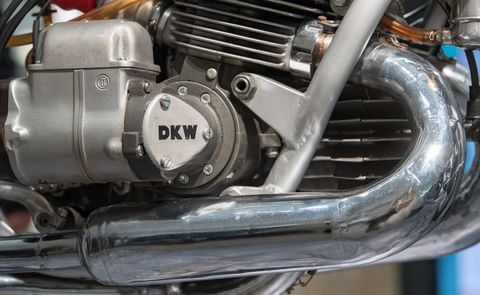[ad_1]
As PopMech’s autos editor, I definitely look at myself a car or truck male. But when it will come to two wheels, the capabilities of contemporary motorcycles astonish me. We now have road-lawful bikes that create around 200 horsepower—from a 1-liter engine—rolling into showrooms with anti-lock brakes, wheelie regulate, and even lean-sensitive traction manage. Whilst these modern-day two-wheelers boggle the head, things applied to be distinctive when two-stroke engines had been early in their enhancement and drum brakes were being the norm.
It all begun in the 1960s with the MZ Racing Crew. At first regarded as Motorrad und Zweiradwerk, which interprets to “motorcycle and two-wheeler factory,” the German motorbike producer took its devices to the racetrack—to incredible accomplishment. These wins and triumphs came thanks to one German missile scientist: Walter Kaaden.
Through Earth War II, Kaaden was a Nazi engineer who is reported to have worked on the V-1 and V-2 rockets. Like many Germans at the time, he was not a Nazi by decision, and was pressured into the occasion following Hitler went to war. Immediately after the Axis defeat, he was wanting to use his awareness for far more peaceful purposes in bikes. His knowing of fuel movement and resonance from rockets authorized him to style an expansion chamber to enhance the power and effectiveness of a bike. Applying an oscilloscope, Kaaden designed changes to the bulbous-shaped exhaust piece that would direct to significant gains in compression, which resulted in far more power.
Kaaden completed this by harnessing the audio waves and exhaust gases emitted from the engine itself. Immediately after every single combustion stroke, the expansion chamber would suck the cylinder cleanse of invested exhaust gases. Then, before the next combustion cycle, it would attract clean air and send it back into the cylinder for extra electric power. Kaaden had in essence figured out forced induction before supercharging and turbocharging. The conclusion consequence was a two-stroke motor that produced up to 200 horsepower per liter, just about double what was earlier possible—the most powerful motor at any time at the time.
In fact, Kaaden’s engines ended up so prosperous that Soichiro Honda (the person driving Honda Motor Firm) tried using to outgun him making use of 4-stroke technologies. To contend with the sheer electricity of Kaaden’s devices, Honda’s engineers attacked the situation with extra pistons when preserving comparable displacement. The end result of their function was the 1966 RC166 bike, which utilized a 250cc twin-cylinder motor that generated 280 horsepower per liter and revved up to 20,000 rpm, a person of the highest-revving engines in the entire world.
Nevertheless, pursuing Kaaden’s results on the racetrack with famed motorbike racer Ernst Degner, the duo break up up for the 1962 time. Degner ended up backstabbing his longtime compatriot by marketing Kaaden’s two-stroke strategies to Suzuki, which was battling to create an engine that would jive with its riders. Degner went on to get the 50cc Environment Championship, single-handedly placing Suzuki back on the map. Kaaden’s MZ devices had won races, but the Suzuki was the to start with two-stroke to gain a world championship. Just after other manufacturers caught wind of what the Japanese motorcycle builder experienced “discovered,” the relaxation was background. Kawasaki would go on to use a carbon copy of Kaaden’s motor in its KR250 and 350 to gain eight planet titles.
This content material is imported from embed-name. You may be ready to obtain the very same written content in another format, or you may perhaps be in a position to come across more data, at their website web site.
Emissions rules eventually inhibited the huge use of two-stroke engines—well identified for spitting tons of smoke and pollution. Having said that, now that we have immediate-injection two-strokes, which can basically run cleaner than present day four-strokes, we could see a resurgence of Kaaden’s equipment. Companies would be equipped to experience the common added benefits of two-stroke engines remaining lighter, much more inexpensive, and now even far more economical.
This content material is established and maintained by a 3rd bash, and imported on to this web page to help users offer their email addresses. You may perhaps be ready to come across more data about this and very similar information at piano.io
[ad_2]
Source link






More Stories
The History of Coventry-Eagle Motorcycles
The History of the Suzuki GT200
A Review of the Suzuki GT500